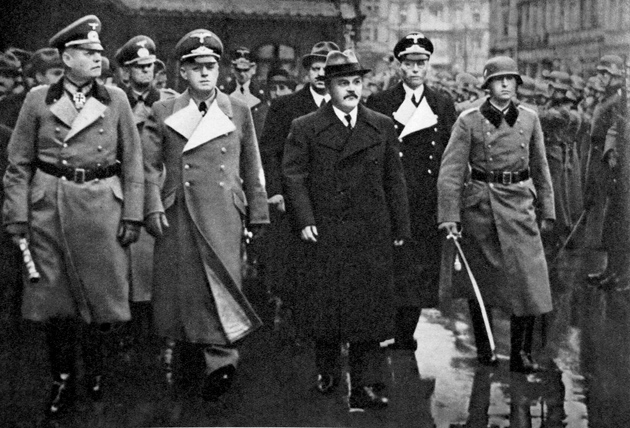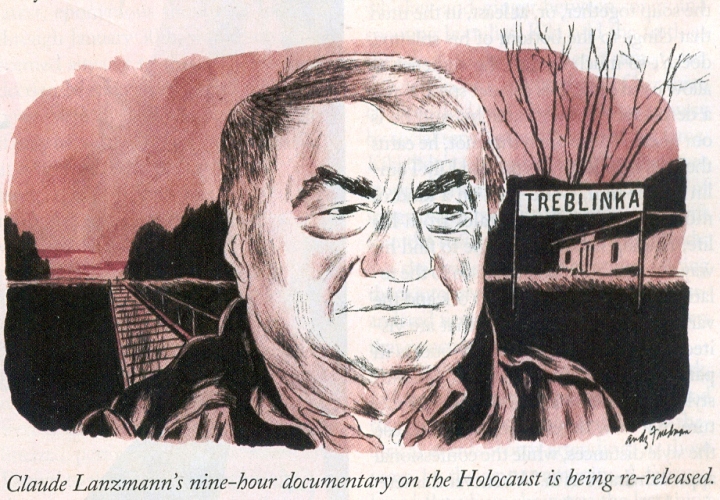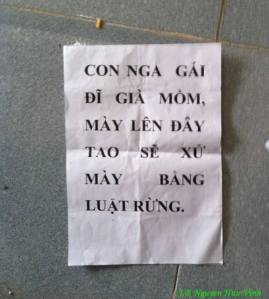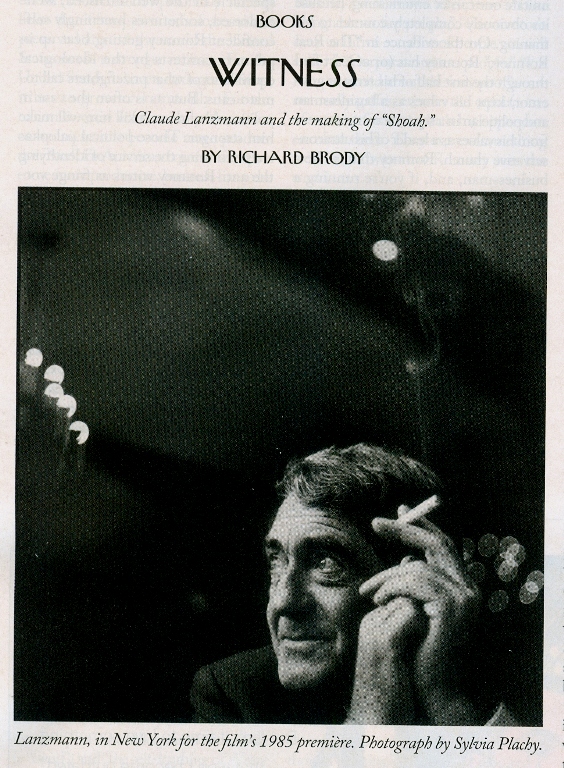 |
Vụ Tổng Công
Kích Tết Mậu Thân 1968 mà lực lượng chính là quân đội miền Bắc xâm
nhập, đã thất
bại về mặt quân sự, nhưng mục tiêu bề trong thâm sâu của chiến dịch đó
chính là
nhằm tiêu diệt những người chiến đấu chống chính quyền miền Nam (VNCH)
vì lý tưởng
dân tộc chủ nghĩa (tin rằng Mỹ xâm lăng VN như kiểu Tây thực dân), do
đó đã phá
nát lực lượng quân sự hậu thuẫn cho phe MTGP miền Nam- Miền Bắc đã
thành công
trong mục tiêu đó, vì đã mượn tay lực lương VNCH miền Nam để làm triệt
tiêu
trên 70% lực lượng chiến đấu của MT Giải Phóng Miền Nam. Nhờ đó sau
1975, miền
Bắc có thể áp đặt quyền lực và mô hình kinh tế giáo điều XHCN trên toàn
miền
Nam mà không bị phe miền Nam chống đối, cho dù kinh tế XHCN làm cho
miền Nam
phá sản, sắp chết đói. (1) Tuy nhiên,
hai phe Cộng Sản/Nazi cũng chơi nhau giống y chang VC Miền Bắc/VC Miền
Nam. Cái tay ký
giả trên tờ The New Yorker, ["Shoah" and a new view of history. BY
DAVID DENBY], khi nhìn lại phim “Shoah”, là dựa theo cái nhìn của tác
giả cuốn "Bloodlands: Europe Between
Hitler and Stalin”: As Snyder demonstrates, the Nazis and the Soviets may have been trying to destroy each other in the ferocious combat of 1941 to 1945, but, if one looks at the entire thirteen-year period that he describes, the two totalitarian powers occasionally acted in a kind of weird concert, in which each side emboldened or even enabled the other. For instance, when the Soviets murdered twenty-two thousand Polish reserve officers in the Katyn forest, in 1940, they were mirroring the German slaughter of the Polish professional classes in German- occupied western Poland. And when the Polish Home Army revolted against the Germans in occupied Warsaw, in 1944, the Soviets, who had encouraged the uprising, fought and defeated the Ger mans outside the city but then waited for months as the Nazis crushed the Poles inside it. When the Soviets finally entered Warsaw, they not only routed the Germans but, with the help of Polish Communists, suppressed the surviving anti-Nazis, thereby finishing the job of subduing the spirit of Polish independence. Without diminishing in any way the Jewish Holocaust, Snyder insists that it should not be seen as separate from the many other mass slaughters of civilians-the millions of Poles, Belarusians, Balts, and Ukrainians killed for political or ideological reasons, or merely because they were an encumbrance that needed to be cleared away to make space for German or Soviet occupancy. Như Snyder
chứng minh, Nazi và Xô Viết có thể cố làm thịt lẫn nhau, trong cuộc đấu
hung dữ
từ 1941 đến 1945, nhưng, nếu có ai nhìn vào toàn thời kỳ 13 năm mà ông
miêu tả,
thì hai tên siêu cường, đại ác, phát xít toàn trị lâu lâu, thi thoảng
lại đi một
bản đồng ca, anh xướng tôi họa rất ư là kỳ kỳ, qua đó, thằng nọ thay vì
tính làm
thịt thằng kia, thì lại hỗ trợ lẫn nhau, y chang anh Tẫu, kẻ thù truyền
kiếp của
giống Mít, đã hỗ trợ anh VC Bắc Kít suốt chiều dài cuộc chiến, trang bị
đến cái
lông chim anh Bộ Đội Cụ Hồ, cũng “made in China”, chỉ đến khi anh Bắc
Kít ăn cướp xong xuôi
Miền Nam thì mới đòi nợ. Stalin, khi ra lệnh tàn sát 22 ngàn sĩ quan
trừ bị Ba
Lan ở Katyn vào năm 1940, là làm 1 cú đồng ca với việc làm thịt những
giai cấp
chuyên nghiệp Ba Lan ở Đức của Nazi ở vùng đất Ba Lan do Nazi chiếm
đóng. Và
khi lực lượng kháng chiến Ba Lan, the Polish Home Army, làm cuộc nổi
dậy ở
Warsaw, vào năm 1944, Xô Viết đã đứng về phía chính nghĩa của nhân dân
Ba Lan, đánh
tơi bời tụi Đức ở bên ngoài thành phố, nhưng đợi hàng tháng trời, cho
Nazi, ở bên
trong thành phố, làm cỏ đám nổi dậy. Cú này, cũng đã xẩy ra trong vụ
Mậu Thân, Bắc
Bộ Phủ ra lệnh cho bộ hạ Miền Nam không được đụng tới những trại lính
Mẽo, và
anh Mẽo, thì cũng chờ hàng tháng, coi bên nào thắng, thì mới ủng hộ
tiếp! The Worst
of the Madness Soviet
Foreign Minister Vyacheslav Molotov, center, arriving in Berlin to meet
with
Adolf Hitler, November 12, 1940. Molotov đi yết
kiến Hitler
Anne
Applebaum, mở ra bài điểm Đất Máu,
Bloodlands,
bằng nhận xét của
Czeslaw
Milosz, nhà thơ Ba Lan, Nobel văn chương. Một lần trong toan tính giải
thích
cho những kẻ ở bên ngoài lịch sử đất nước ông, ảnh hưởng của
chiến
tranh, xâm lăng, và Lò Thiêu lên con người bình thường: Bạo lực tập
thể, mass violence, ông giải thích, làm lung lay cảm
quan con người về công lý tự nhiên, nature justice. Vào thời bình, khi
đụng 1 xác
chết trên
đường phố, bạn kêu cảnh sát, hoặc “bớ người ta!” một phát, và mọi
người xúm lại…
Bây giờ, bạn phải chuồn cho thật lẹ, và tránh thật xa cái xác chết
đen thui nằm đen thui đường phố. Thế thì Mít,
sao? 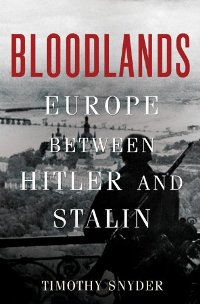 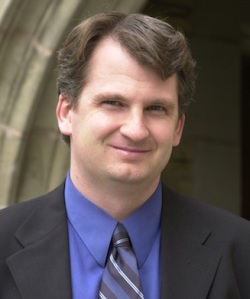 THE Q&A:
TIMOTHY SNYDER, AUTHOR
What are
some of the most common misconceptions of the history of the so-called
"bloodlands"? The first is that there’s something that people think they understand and it turns out that they don’t, and that thing is the Holocaust. The reality of it is, if anything, worse than they think, much more face-to-face, much more barbaric, much more unforgettable. People think that the Holocaust is something that happened in Germany, generally to German Jews. They think it’s something that happened only in Auschwitz. They generally don’t know about any of the other death facilities besides Auschwitz; they generally don’t know that half of the Jews who were killed were shot rather than gassed. Hitler and Stalin killed virtually in the same place, and that is Ukraine, Belarus, Poland, the Baltic states, western Russia. The Holocaust happened in a place where millions and millions of people have just been killed due to the Soviet policies. And the third thing I would point to is the habit of reduction. For example an approach saying: it must have all been the Germans, or it must have all been the Soviets. Both of these systems brought tremendous death and suffering. If you want to avoid criticism then you shouldn't be a historian, because historians are trying to understand and explain. If you're trying to please people then you should go into the fashion business, or the candy business.
Khi “Shoah”
ra lò vào năm 1958, nó lập tức biến thành lịch sử. Tông
tông Pháp lúc đó, Francois
Mitterrand đi coi ngày đầu
chiếu. Nhà cầm quyền Ba Lan đề nghị cấm. Gorbachev ra lệnh, chỉ một vài
lần chiếu
cho công chúng coi, ở Liên Xô, vào năm 1989. Vaclav Havel coi ở trong
nhà tù
Czechoslovak.
What
he doesn't emphasize (he says it in passing) is that Hitler's war
against the
Jews was an attempt to eliminate an entire people-to efface their
identity
altogether-whereas Stalin's campaign against, say, Ukraine was an
attempt to
eliminate not all Ukrainians but those who conceivably might resist
collectivization and the triumph of Communism. Điều ông không
nhấn mạnh là cuộc chiến của Hitler chống lại Do Thái, là toan tính làm
cỏ cả một dân tộc – xóa sạch căn cước của 1 giống dân – trong khi cuộc
chiến dịch của
Stalin chống lại Ukraine là toan tính làm cỏ không phải toàn thể dân Ukraine
mà là
những người chống lại tập thể hóa, và chiến thắng của Chủ Nghĩa Cộng
Sản. Khi đám VC Bắc Kít thắng
cuộc chiến, và đẩy đám sĩ quan Ngụy lên
miền rừng thiêng nước độc Bắc Bắc Việt, và chiến dịch tiếp theo, sẽ đưa
hết đám
vợ con Ngụy lên đó, chẳng phải là để xóa sạch tất cả đám Ngụy, "một
nửa" giống dân
Mít? Cái điều mà VC Bắc Kít tính làm với Ngụy, thì bây giờ chúng làm với tất cả nước Mít, người Mít WATCHING
SHOAH IN A
Coi phim Shoah
Tờ "Người Nữu Ước" đọc "Hồi Ký" của Lanzmann, bản tiếng Anh, và hoàn cảnh phim “Shoah” ra đời. Simone de Beauvoir viết về phim Shoah: Thật khó mà
nói về phim này. Có điều gọi là huyền thuật ở trong đó, mà,
huyền
thuật làm sao diễn tả? Tờ
TLS khi đọc Hồi Ký của Lanzmann, cho biết, ông đứng hàng thứ bẩy, trong
số những
người tình của De Beauvoir. -Phim
gì? Sau
khi "xong", Lanzmann xin bà chị cái xịp làm kỷ niệm, bà chị thủ thỉ, "Shoah"
and a new view of history. Witness Claude
Lanzmann and the making of “Shoah” When
"Shoah" was released, in 1985,
it was instantly historic. The nine-and-a-half-hour film about the
German death
camps in Poland is composed mainly of interviews with Jews who survived
them;
Germans who helped run them, and Poles who lived alongside them. As
most of its
first critics noted with surprise, the film contains no archival
footage. With
its long takes of extraordinarily detailed yet emotionally shattering
testimony, "Shoah" turns the bearing of witness into its subject. It
was immediately received as a cinematic object a incommensurable as its
director intended to show the Holocaust itself to be. Francois
Mitterrand, then the President of
France, attended the premiere screening, after which the Polish
government
asked France to ban the film. Mikhail Gorbachev ordered a few public
screenings
in the Soviet Union, in 1989; Vaclav Havel saw "Shoah" in a
Czechoslovak prison; the film's ongoing travels around the world remain
newsworthy, as when, in January, it was shown on state television for
the first
time in Turkey. For many, especially in Europe, its title (Hebrew for
“catastrophe") has superseded the term "Holocaust." Its
maker, Claude Lanzmann, seemed to come
from nowhere, even as he imposed his vision everywhere. At the
premiere, the
editor Jean Daniel told him, “That justifies a life." "Shoah"
was only Lanzmann's second
film. He was fifty-nine when it came out; nothing he did before it, and
nothing
he has done since, rivals it in significance. The amazing back-story
finally
emerges in his autobiography, "The Patagonian Hare" (Farrar, Straus
& Giroux), which was published in France in 2009 and now appears in
English, in a translation by Frank Wynne. Here Lanzmann sets forth the
peculiar
yet exemplary fund of life experience that made the film possible. He
tells
vivid tales of his formative years, and of the wild dozen of them that
went
into the making of "Shoah." The memoir reveals that Lanzmann's
masterpiece is both a reflection of the film-maker's distinctive
character and
a product of its place and time. A late flowering of his intellectual
and
cultural milieu - existentialism and the French New Wave - it is among
the most
distinguished works of art to come out of the late twentieth century. Lanzmann,
who was born in Paris in 1925, was
the child of assimilated French Jews, and learned at a young age that
assimilation was also a matter of prudence: "Hiding behind a pillar in
the
school playground I watched- petrified, making no attempt to intervene,
terrified that I might be discovered-as my classmates all but lynched a
lanky,
red-haired Jew named Levy who had all the features of pre-war anti-
Semitic
caricatures. They were twenty against one and they beat him until he
bled." His
mother had left the family home in 1934;
Claude and his two siblings, who were younger, moved with their father
to his
small farm in rural Brioude. When the war broke out, Lanzmann père took
precautions-he dug an underground shelter and timed his children as
they
practiced their escape to it from their beds. Claude
quickly revealed himself to be an intrepid
risk-taker, joining the Resistance while in high school, under the
aegis of the
Communist Party. (He was, at the time, unaware that his father was the
head of
the local Free French Resistance forces.) The harrowing years of war at
home
seem to have had the same galvanizing effect on Lanzmann that service
in the
Pacific theatre had on Norman Mailer: the quest for action became a
lifelong
ideal. Lanzmann's intellectual hero in his project was Jean- Paul
Sartre, whose
name appears more often than any other in "The Patagonian Hare," and
who provided Lanzmann with the cerebral adventure to go with the
physical kind. With
France liberated in late 1944, Lanzmann
moved to Paris, where he attended the prestigious Lycée Louis-le-Grand.
Enthralled with Sartre's "Being and Nothingness," and with his novels
"The Age of Reason" and "The Reprieve," Lanzmann embarked
on what he called his "year of ever more insane challenges," which
included the impersonation of a priest in order to pocket donations and
the
theft of philosophy books from the university's bookstore. It also
involved
audacious seductions, but there he had help at home - his mother's
lover, the
Serbian Jewish poet Monny de Boully, procured for him a mistress, an
unhappily
married businesswoman, and joined with Lanzmann's father to buy him a
luxurious
initiation into one of the grand brothels of Paris. Lanzmann read
Sartre's
"Anti-Semite and Jew" when it was published, in 1946, and was
electrified by its arguments. In Sartre's analysis, anti-Semitism
emerged as a
seductively self-sparing form of "sadism"; he called the anti-Semite
a "coward" and a "malcontent who dares not revolt from fear of
the consequences of his rebellion," and he faulted the "inauthentic
Jew," with his "perpetual oscillation between pride and a sense of
inferiority," for internalizing the anti Semite's hatred. Lanzmann
writes,
'With every line I felt alive again or, to be more precise, I felt I
had been
given permission to live .... Sartre, the greatest French writer,
understood us
as no one else had ever done." In
1948, Lanzmann, armed with a degree in
philosophy from the Sorbonne (he specialized in Leibniz), went to
Berlin to
teach philosophy and literature to German students. He granted his
students'
request to hold a seminar on anti-Semitism (centered on Sartre's book),
but the
French military commander in Berlin ordered him to desist, on the
ground of
political sensitivities. Lanzmann, who had come to believe that
denazification
was "a joke," angered French officials with all article that he
published in an East Berlin newspaper about the university
administration's
Nazi sympathies. A
Marxist who didn't join the Communist Party,
Lanzmann decided to "secretly infiltrate" East Germany, where he
slept "in public squares, under bushes in parks," while observing the
newly established country and conducting interviews a step ahead of the
authorities. He published his findings in a series of articles in Le Monde, prompting Sartre to invite him
to attend editorial meetings of his journal, Les Temps
Modernes. Quickly becoming a familiar and enthusiastic
figure in Sartre's circle, Lanzmann sensed in himself a growing
attraction to
one of his colleagues-the writer Simone de Beauvoir, who was Sartre's
former
lover and remained his inseparable companion. In the summer of1952,
Lanzmann
decided to go to Israel to do research for a series of articles, but on
the eve
of his departure he invited Beauvoir, seventeen years his senior, to
the
movies: "Which
film?" she asked bluntly,
clearly ill-disposed to wasting her time. "Any film," I said, my way
of saying that it was not the point of my invitation. She understood. They
spent the night in her apartment, and,
after they made love, Beauvoir confessed to him, ''1 must tell you,
there have
been five men in my life." Lanzmann writes that he knew he "was to be
the sixth man." During
his months in Israel, he carried on an
intensely romantic correspondence with Beauvoir, and, when he returned
to
Paris, he moved in with her. 'We
lived together as a married couple for
seven years, from 1952 to 1959," Lanzmann writes. ''1 am the only man
with
whom Simone de Beauvoir lived a quasi-marital existence." The
relationship with Beauvoir propelled this
twenty-six-year-old tyro into the highest reaches of French culture.
Spending
lots of time with Beauvoir also meant spending lots of time with
Sartre. The
fact didn't escape Lanzmann, who, in 1982, admitted to Deirdre Bair,
Beauvoir's
biographer, "Okay, so I was an opportunist-'on the make,' you say. But
she
was beautiful! My attraction to her was genuine." And he regarded the
exchange as a fair one, writing, "They helped me to think; I gave them
food for thought." If
Sartre thought that man was defined by his
actions, Lanzmann was, in the most concrete way, a man of action. "The
Patagonian Hare" is filled with Lanzmann's accounts of his adventures:
he
climbed up mountains and skied down them; he piloted gliders, became
adept at
deep-sea diving, learned to hunt; he rode in tanks and fighter jets,
and
reported from the front lines of battle. He also describes his sexual
exploits,
devoting dozens of pages to one erotic challenge that combined
uninhibited lust
with high-wire audacity: a thwarted love affair, during a leftist press
junket
to North Korea in 1958, with a Pyongyang nurse. After an unauthorized
rowboat
excursion, the nurse faced trial in an impromptu court of Party
officials in
the hotel, and Lanzmann stormed into its session to plead her cause. His
most arduous adventures, though, were
intellectual in nature. During the trip to Israel, Lanzmann had
received a
lesson in Jewish identity, and decided that Sartre's book-in
particular, its
thesis that "it is the anti-Semite who creates the Jew"-was in need
of revision. Back in Paris, he told Sartre so. Sartre encouraged him to
write a
book of his own; at the desk that Beauvoir had installed for him in her
cramped
studio apartment, he wrote a hundred pages, and she and Sartre praised
them,
but Lanzmann abandoned the task. He knew that he was serving a rare and
unique
apprenticeship, and knew, too, that he "needed to grow up": "I
was a man slow to mature, I was not afraid of the passing of time.
Something
told me that my life would reach its full potential in its second half". In
the seven years that he lived with
Beauvoir-they broke up in 1959 but remained close friends-Lanzmann
spent one
afternoon and one evening a week as an editor for the tabloid-style
weekly France Dimanche. He also took on freelance
assignments, including a regular monthly gig at Elle,
but turned down full-time work in order to keep his
"freedom." Lanzmann specialized in criminal investigations and
celebrity interviews (he recently published a collection of his
articles,
"La Tombe du Divin Plongeur"), but most of his activity was
political. He was prosecuted for signing the Manifesto of the 121,
calling for
French soldiers in the Algerian War to refuse orders to fight. Then,
Lanzmann
writes, the Premier of the newly independent Algeria, Ahmed Ben Bella,
declared
that he would send "100,000 troops to liberate Palestine." Lanzmann
was disheartened. "For me, it was over," he recalls. "I had
thought it was possible to believe both in an independent Algeria and
the state
of Israel. I was wrong." The first sign of his new-found devotion to
Israel was a special, thousand-page edition of Les Temps
Modernes on the
Arab-Israeli conflict, which he spent two years editing and which
happened to
appear on June 5, 1967-the first day of the Six-Day War. Meanwhile,
Lanzmann was hired to do on-camera
reports for a television variety show, a job that led him to the great
adventure of his life, the cinema. After reporting in 1968, for a TV
news show,
from the Israeli Army's front lines in the Sinai Peninsula, Lanzmann
concluded
that the broadcast would have been better if he had supervised the
editing. By
chance, a wealthy patron offered him the opportunity to make a
documentary
about Israel. He went there for another visit; soon after arriving, he
met and
fell in love with Angelika Schrobsdorff, an émigré writer from Germany,
and he
agreed to make the film "Pourquoi Israel" ("Israel, Why"),
"consumed by a single thought: seeing Angelika again, going back to be
with her as soon as possible." They married in 1974, the year after the
movie was completed. It
features interviews with a wide range of
Israelis-intellectuals and laborers, Europhilic German Jews and
frustrated
young Sephardic Jews, leftist kibbutzniks and Hasidic proselytizers and
West
Bank settlers. The staunchly Zionist film offers a keen perspective on
Israel’s
social and political conflicts, but, in an era marked by the work of
such
documentary innovators as Frederick Wiseman, Richard Leacock, D. A.
Penne-baker, Shirley Clarke, and the Maysles brothers, it hardly stands
out for
originality of style-sand certainly didn't prepare the world for the
shock of
"Shoah." Had
Lanzmann done nothing more, he would be
remembered chiefly, and faintly, as a sort of intellectual and
political Zelig;
his most enduring trace would likely have been his prominent cameo in
Beauvoir's memoir "Force of Circumstance" (1963). There she describes
her young lover: To
define himself, he said first of all: I'm a
Jew .... When, at the age of thirteen, he discovered anti-Semitism, the
whole
world was shaken, nothing survived intact .... His experience [in the
Resistance] had presented an image of the Jews not as people resigned,
humiliated, persecuted, but as fighters. The six million men, women and
children exterminated by the Nazis belonged to a great people not
predestined
to martyrdom, but the victim of gratuitous barbarism .... Although he
had many
friends among them, his bitterness toward the Goyim never disappeared.
"I
want to kill, all the time," he told me. 1 could feel, buried inside
him,
flexing its muscles, a violence always ready to explode. Sometimes in
the
morning after some disturbing dream, he would wake up shouting at me:
"You're all kapos!" ... A Jew and an eldest son, the responsibilities
with which Lanzmann had been burdened from childhood on had produced a
precocious maturity in him; sometimes he seemed to be carrying the
weight of a
whole ancestral experience on his shoulders. Beauvoir's
sketch conveyed some of the traits
that made "Shoah" possible. She didn't
catch the originality of his
thought-perhaps because, at the
time of her writing, it wasn't there to be seen. It may have been
contact with
the right subject at the right time that allowed it finally to emerge. "Shoah"
was not Lanzmann's idea. It
was commissioned, in 1973, by Alouph Hareven, a friend of Lanzmann's in
the
Israeli Ministry of Foreign Affairs, who, having seen "Israel, Why,"
suggested that Lanzmann make a film about the Holocaust from "the
viewpoint of the Jews," a film that is not "about the
Shoah, but a film that is the Shoah." Lanzmann spent a
year doing research on a
subject that he thought he knew about "innately." He discovered, from
reading books, watching films, and talking with survivors, that what
was most important was missing: the gas
chambers, death in the gas chambers, from which no one had returned to
report. The
day I realized that this was what was missing, I knew that the subject
of the
film would be death itself, death rather than survival, a radical
contradiction
since in a sense it attested to the impossibility of the project I was
embarking on: the dead could not speak for the dead .... My film would
have to
take up the ultimate challenge; take the place of the non-existent
images of
death in the gas chambers. The
story of the making of "Shoah"
is as exciting as a spy novel. Lanzmann wanted to interview Jewish
survivors
who had been in close proximity to the dead-members of the
Sonderkommandos
(Special Units), who had been ordered by German officials to help
unload newly
arrived Jews from trains and to dispose of their bodies after the mass
killings. (Rejecting the charge that these forced laborers had been
willing
collaborators, Lanzmann shows that they endured their mission with the
intention of bearing witness for those who didn't survive.) He spent
two years looking
for Abraham Bomba, who was in the detachment of Jewish barbers ordered
to cut
the hair of men and women who were about to be gassed in Treblinka.
Finding
Bomba in the Bronx (it took a stakeout of his house), Lanzmann secured
his
cooperation but, in the subsequent two-year quest for funding to film
the
sequence, lost contact with him again, only to track him down in
Israel. Lanzmann's
search for Germans who had held
jobs in the death camps was even tougher: many of those whom he located
refused
to speak with him on- camera, but movie technique and sheer nerve came
to the
rescue. Lanzmann got hold of a pafuche,
or paw, a slender, stick-like video camera newly devised by the
innovative
designer Jean- Pierre Beauviala. Lanzmann hid it in a bag with a tiny
hole for
the lens, and had one of his cameramen point it at an unsuspecting
interview
subject. He hid a small microphone behind his tie. A van was rigged
with video
and radio equipment that rendered the stealthy images and sounds on a
television set. 'What qualms should I have had about misleading Nazis,
murderers?" Lanzmann recently told Der
Spiegel. 'Weren't the Nazis themselves masters of deception?" He
believed that his ruses served the higher good of revealing the
truth-and
perhaps accomplished symbolic acts of resistance after the fact. As he
explained in 1985, "I'm killing them with the camera." The
most impressive application of the pafuche was the
surreptitious filming of
Franz Suchomel, an officer at Treblinka, whose chillingly proud
description of the
camp ("a definitely primitive but well-functioning assembly line of
death") and cheerful intoning of the official camp song ("No Jew
knows that today') are among the film's most shocking revelations, and
also one
of its most cinematically ingenious constructions. For the most part,
the rig
worked superbly, and Lanzmann and his crew became adept at introducing
themselves to former Nazis and snatching their stories. But, during one
such
interview, Lanzmann and his assistant were unmasked, attacked, and
bloodied by
the subject's son and three young toughs; after being hospitalized for
a month,
Lanzmann was charged with unauthorized use of the German airwaves. (The
charges
were ultimately dropped.) In
1978, Lanzmann, dutifully, went to
Poland-"only to confirm that I had not needed to come." Among the
remains and the memorial settings at the camps, Lanzmann writes, he
"felt
nothing." Then, driving near the sites, he noticed the local residents
walking nearby and had the "shattering revelation" that those who were
at least fifty years old would have clear recollections of the death
camps: I
saw a sign: black lettering on a yellow
background that indicated, as though nothing had happened, the name of
the
village we were approaching: "TREBLINKA." ... Treblinka became real,
the shift from myth to reality took place in a blinding flash, the
encounter
between a name and a place wiped out everything I had learned, forced
me to
start again from scratch. In
Poland, determined to give "the
geographical heart of the extermination" the "crucial place it
deserved," he filmed interviews with people in the towns of Treblinka,
Chelmno, and Oswiecim (the Polish name of Auschwitz). Many Polish
villagers, he
found, remained disturbingly unsympathetic to the fate of their Jewish
neighbors.
(He came to believe that anti-Semitism in Poland was one of the
"essential
conditions" for the Holocaust.) He also filmed the sites of the
camps-the
museum-like preservation of Auschwitz, the bare ground of Chelmno, the
granite-shards memorial at Treblinka. His cameramen thought that he was
becoming obsessed with filming these "stones," and he himself
volunteers that he may have been "in the grip of a sort of madness."
The most audacious thing Lanzmann did to complete "Shoah" was, very
simply, to take his time. His initial backers expected him to deliver a
two
hour film in eighteen months; his response was to lie-to promise that
it would
be done as specified, and then to continue working as he saw fit.
Lanzmann
borrowed money (including from Beauvoir) to keep shooting, and then
spent five
years obsessively editing his three hundred and fifty hours of footage.
He
writes that he became the "master of time," which he considered to be
not only an aspect of creative control but also one of aesthetic
morality. He
sensed that there was just "one right path" to follow, and he set a
rule for himself: "I refused to carry on until I had found it, which
could
take hours or days, on one occasion I am not likely to forget it took
three
weeks." He
made the movie without voice-overs and
without subtitles, keeping the responses of his interview subjects on
the
soundtrack along with his own questions (in French, German, Italian,
and
English) and the voices of his Polish, Yiddish, and Hebrew
interpreters. The
result is a symphonic mixture of voices (the talk in the film is nearly
constant, and constantly transfixing), as well as a gripping array of
faces and
gestures. In the editing room, Lanzmann subtly transformed the
interviews. He
often substituted, for the speaker's face, images of the present-day
sites of
the camps, the "stones," and that disjunctive pairing of witnesses
with places became the crucial trope of the film-which he even
considered
titling "Le Lieu et la Parole" ('The Place and the Word"). The
events described in the witnesses' testimony seem to come to life upon
contact
with the sites where they occurred. In one sequence, Mordechai
Podchlebnik, a
survivor of Chelmno, describes the departure from a courtyard of a
sealed van
packed with Jews who were being killed by its exhaust fumes. Meanwhile,
the
camera recedes from that very courtyard, looking back - evoking, with a
haunting immediacy, the point of view of the dead. By inhabiting the
death-camp
sites and other modern locations, his wit-nesses' intimate testimony
seem to
fill their expanses; in turn, these sites, marked by specific memories,
seem to
yield up their history in palpable form. Lanzmann repudiates the use of
the
term "documentary" for "Shoah," claiming that the film
"defies and eludes the categories of documentary or fiction." His
realization of history in the present tense, which he achieved largely
in the
editing room, is as signal an act of cinematic modernism as the
disjunctive
editing that Jean- Luc Godard hazarded with his first film,
"Breathless"-yet, as with Godard's film, the editing of
"Shoah" was only the culmination of the unusual approach to shooting
that had preceded it. Although
the testimony in "Shoah" is
authentic, many of its scenes are staged. To film Bomba, the retired
barber who
had cut hair at Treblinka, Lanzmann got him to borrow a chair in a
working
barber-shop and pretend to cut a friend's hair while telling the
story-and
Lanzmann maintains that, while cutting his friend's hair, Bomba "became
an
actor." In Poland, Lanzmann rented a steam locomotive for a conductor
to
drive on the same tracks along which, four decades earlier, he had
pushed
freight cars filled with Jewish captives. Indeed, the opening scene of
"Shoah"
is a declaration of aesthetic intent: it shows Simon Srebnik, a
survivor of Chelmno,
in a rowboat similar to the one in which he had travelled on work
detail with
S.S. men, singing one of the songs with which he had serenaded his
captors. The
scene is obviously no spontaneous occurrence but a setup-Srebnik's
imitation of
his younger self, at Lanzmann's behest. Lanzmann
calls "Shoah" "a
fiction of the real," and says that he was imagining himself as much
into
the minds and the souls of the killers as of the victims. He
was aware of the moral risks he was taking,
but he believed that he was both obeying "the categorical imperative of
the search for and the transmission of truth" and making a work of
"beauty." At the time of the film's release, Lanzmann said, "I
believe very deeply that art and morality are identical. I didn't try
to make a
document but a real movie, and I wanted it to be beautiful," in order
to
"make the unbearable bearable." The result was a resounding response
to Adorno’s assertion that "to write poetry after Auschwitz is
barbaric." The
final shot of the film, which shows a
train advancing toward the camera, and partly disappearing behind the
edge of the
frame, is an unmistakable reprise of the Lumière brothers' "Arrival of
a
Train at La Ciotat," the 1895 short film that they presented at one of
the
first public exhibitions of their new invention, movies. It's as
ifLanzmann
were inscrib-ing "Shoah" into the history of cinema-or, rather, past
it, as the first film of a reborn cinema. With
its looping, associative storytelling,
Lanzmann's autobiography describes many latter-day events, including
his
fighter-jet flights while making the 1994 film "Tsahal" and a recent
return trip to China and North Korea. But its over-all arc runs from
his
childhood through the release of "Shoah" and events that followed
closely in its wake: the death of Beauvoir, in 1986, and his subsequent
appointment as the editor-in-chief of Les
Temps Modernes (a position that he still holds). "Shoah" is not,
of course, the end of Lanzmann's life or career, but it is his defining
act,
and there's little he can do for an encore. Lanzmann has shown no
inhibition
about getting involved in public de-bates regarding the Holocaust,
including
the one that arose after the French release of Steven Spielberg's
"Schindler's List." (He called the film "an illustrated
'Shoah,'" and maintained that, for Spielberg, "the extermination is a
decor.") In 'The Patagonian Hare," he dismisses the charge that
"Lanzmann somehow considers that he owns the Shoah." Yet
"Shoah" seems to own Lanzmann. Not only does that film in-deed
"justify a life"; it also continues to dominate it. Starting in 1997,
he has crafted three feature-length films from its outtakes: "A Visitor
from the Living," centered on an interview with Maurice Rossel, the Red
Cross representative who, in July of 1944, delivered a favorable report
about
Theresienstadt; "Sobibor, 14 October, 1943, 4 p.m.," featuring Yehuda
Lerner, who participated in the uprising of inmates against the Sobibor
camp
guards and succeeded in escaping; and "The Karski Report," in
which the Polish resistance fighter Jan
Karski describes his visit to Franklin Roosevelt in 1943. Lanzmann is
currently
at work on a fourth such film, about Theresienstadt. There's much more
where
that came from. Two hundred and twenty hours of Lanzmann's interview
footage is
housed at the United States Holocaust Memorial Museum, in Washington,
D.C.; to
date, more than seventy per cent of it has been restored and can be
viewed
there. In January, at the Film Society of Lincoln Center, the museum
presented
a set of out-takes. They have a devastating emotional force. But they
also
highlight the vast difference between raw interviews and the editorial
transfiguration of them that is the hallmark of Lanzmann's art. And
they make
clear that his genius for his singular subject may also be his singular
burden.
+ THE
NEW YORKER MARCH 19, 2012 |
